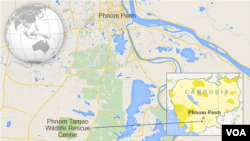An expanding crackdown in Southeast Asia on the trafficking of endangered species has led to a new challenge - what to do with the thousands of animals rescued every year.
That issue is on full display at the Phnom Tamao Wildlife Rescue Center, about an hour's drive south of the Cambodian capital, Phnom Penh.
The calls of gibbons resonate across the 2,400-hectare protected forest with exotic birds occasionally joining the chorus.
Many of the animals arrived here after being seized by Cambodia's Wildlife Rapid Rescue Team, composed of government officials, military police and staff of the U.S.-based non profit Wildlife Alliance.
Every year the team rescues hundreds of endangered animals, thanks in large part to tip offs from Cambodians to a hotline.
Booming trade in endangered wildlife
Illicit commerce of animals is the world's third largest black market, behind weapons and drugs.
It is a multibillion-dollar enterprise, involving well-organized criminal syndicates and corrupt or apathetic officials, removing species from the wild faster than they can repopulate.
At this government-owned refuge is the biggest sun bear population in captivity (around 100), in addition to several dozen moon bears.
The entire reserve would sustain only a single bear in the wild, says Anuradha Jayasinghe, a technical adviser with Free the Bears.
Two of the bears from here were set free after a gradual reconditioning process in another part of the country.
“The bears were doing fine for about three months, roughly. But, then, unfortunately they both got snared again by poachers, explains Jayasinghe. "So that’s the main issue in Cambodia is the hunting. It’s just the forests aren’t safe, at the moment, for releasing bears. And then the forests we might be able to (release animals) are full of mines.”
There has been modest success with other species.
More than two thousand rare turtles, taken from traffickers in a cross-border law enforcement operation, were repatriated to their native wild home in Indonesia in February.
The “pig-nosed” turtles had been confiscated the previous month in Hong Kong.
Pangolins, a mammal often called "scaly anteaters," are hunted for food and medicine, leading them to become the most frequently seized mammal in Asia's wildlife trade. That has lead to a "great decline" in their populations in Cambodia, Vietnam and Laos, according to the Worldwatch Institute.
In the first half of this year more than 1,200 live pangolins were confiscated, in addition to nearly four tons of scales (which are sold for about $3,000 per kilogram). The haul was seized from traffickers in China (including Hong Kong), India, Indonesia, Nepal, Pakistan and Thailand.
At Bangkok's main international airport there are frequent seizures of 300 to 500 turtles or tortoises at a time.
Authorities in Thailand, a major transit point for smugglers, report seizing more than 10,000 live animals and 1,300 carcasses in 2013.
Few homes for rescued wildlife
The wildlife found at Thailand's ports end up at 24 overcrowded centers across the country.
Most will stay in the centers for the rest of their lives. In many cases the countries of origin are not known and those nations would need to request their animals be returned, which does not usually occur.
It is not unusual for hundreds of slow lorises to be discovered in a single raid or intercepted airport shipment.
“Most of the slow lorises have their teeth clipped so they can’t survive if you take them back [to the wild]. Or they’ve been hand raised, " says Nancy Gibson, founder of Love Wildlife Foundation. "And they’re naive little creatures that don’t know how to hunt. So there’s a lot of difficulties behind that and you have to keep them in the centers.”
She says caring for such animals is a "never-ending process" that places a “huge burden” on governments and NGOs.
"There’s a lot to consider because you have to keep an animal and you have to take care of it for the rest of its life. This can be anywhere from three years, even to ten years. And if you have a lot of bird species and tortoises this can be 50 years,” says Gibson, who started her Thailand-based NGO a decade ago.
Putting the seized animals in zoos in Southeast Asia is usually not an option because the facilities are over-burdened with a surplus of creatures dumped at their gates by people who have tired of caring for exotic pets.
Well-meaning tourists add to problem
A live tiger on the black market in Asia will sell for $50,000. Assorted body body parts from a dead tiger can be worth in total tens of thousands of dollars more, according to law enforcement officials.
A live monkey in Thailand can be purchased for under $50 while a healthy owl can be bought in India for about $250.
Gibson explains that many well-intentioned animal lovers will purchase such animals they see on the street, thinking they’re helping to free them from deplorable situations.
“But this is actually something that is feeding the trade. So you’re not actually helping the situation," she says. "They will take more from the wild because this is part of their business. If possible, just don’t support it at all. Keep reporting it [to authorities]. Whether something actually happens or not you should always keep reporting it.”
Activists want tougher penalties to dissuade smugglers and hope to find ways to compel countries where the animals originated to take more responsibility for them.
Another problem is that many of the kingpins of animal trafficking enjoy immunity from arrest or prosecution due to corrupt officials.
That all means the chorus of rescued animals being kept in this Cambodian refuge will have more voices joining it in the future.












